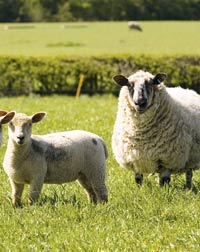Home grown forages can cut sheep feed costs

Alternative forages can improve feed efficiency for sheep producers and help improve feed self-sufficiency
Home grown forages can cut sheep feed costs and fill feeding gaps, says Helen Mathieu, area sales manager for British Seed Houses.
“Brassicas are highly flexible, providing either a catch crop in the summer or a main feeding crop in the winter,” she says.
“With growing costs of about 3p/kg of dry matter, brassicas enable good use of land in crop rotations and provide low-cost good quality nutrition.”
The type of crop you decide to use will depend on when you want to use it. “Ask yourself when you are seeing a forage deficit and match the crop to the gap.
“If you are able to sow by the end of June for winter feeding, use a kale. However, if you are looking to fill a gap after cereals, opt for a faster growing, hardy variety, such as a kale/rape hybrid, which offers the greatest versatility.”
Fodder beet, kale and swedes can also act as good main crops for winter feeding. “Fodder beet sown at the end of March to beginning of April, can be fed from November onwards as a main crop. This is a costly crop to grow and ‘fussy’ but can be extremely productive.”
Last year, sheep farmer, Oliver Doubleday, began finishing lambs on brassicas at Hempstead Farm, Tonge, Kent. “Lambs are put on brassicas in late June at about 10 weeks of age until finishing in August. We currently have more than 2000 lambs grazing on these alternative forages.”
The farm is located in a dry area in Kent, so forages are selected to thrive in these conditions. “Last year we grew a leafy turnip which proved quite drought resistant with good re-growth in dry conditions.”
This year, the farm has introduced rape/kale hybrids with some success. “Grazing hybrids has allowed us to cut back on creep feed – proving highly cost effective.”
Lambs are doing well, he says. “The high quality hybrid variety has proved very palatable.” One of the factors effecting successful grazing hybrid brassicas is ensuring lambs are pushed to eat enough of the stalk. “Lambs need to eat both stalk and leaf to get a good balance of protein and carbohydrate.”
Brassicas must be introduced slowly to give animals time to adapt to the new diet, Ms Mathieu continues. “Provide a run back of grass alongside a supply of hay and straw.”
“The diet should be made up of about 80% brassicas and 20% fibre. However, some farmers are successfully feeding 100% brassicas.”
Mr Doubleday has also planted kale to provide a crop for flushing ewes. “Kale is planted in the spring. It is slow growing and holds its quality for long periods without problems, meaning we can either use it for finishing lambs or flushing ewes,” he says.
Three years ago, Mr Doubleday began an aggressive re-seed programme to try and increase the quality of his grazing swards. This involved introducing chicory, high sugar grasses and clover leys.
“The big tap root in chicory means it has the ability to persist into July and August when the grass has generally run out of steam providing a high quality, good feed for ewes and lambs.”
Chicory provides huge benefits, says Ms Mathieu. “I have seen more lambs finishing early and ewes maintaining condition and milking better on grass leys incorporating chicory.”
Ideally, chicory should be sown in the spring, however, it can be sown in early autumn as long as it is in before the end of August, says Adam Simper, seed specialist for Wynnstay. “Feeding a 100% chicory sward, or a red clover and chicory mix can achieve growth rates of 300-400g a day.”
In fact, a trial carried out by EBLEX at Newton Rigg showed lambs on a grass, clover and chicory ley had higher growth rates with 28% more lambs finished in the same period compared to those on grass and clover leys.
Chicory also plays a role in reducing worm burdens, says EBLEX beef and sheep scientist, Liz Genever. “The structure and quality of the plant and how it is grazed all impact on worm burdens,” she says. “For example, tannins and other compounds in the plant could act directly on the nemotodes in the gut to reduce their efficiency.”
Plantane is also a fantastic sheep finisher, says Mr Simper. “Plantain is a mineral rich perennial herb, which can act as a good addition to grass leys at a seed rate of 0.5kg/ac.” “The plant is particularly high in selenium which is often deficient in sheep.”
Sheep exhibition at show |
|---|
| The Sheep Exhibition at the Dairy Event and Livestock Show developed in association with NSA will feature the leading UK breeds and focus on grassland management, nutrition and solutions to animal health issues and will also offer a live demonstration with the latest ID and handling systems throughout the two day event. |
Click here for more information on the event.
